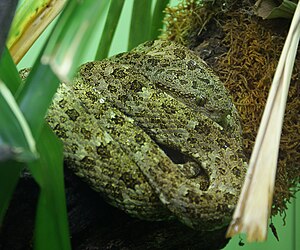Bothrops taeniatus
| Bothrops taeniatus | ||||||||||||
|---|---|---|---|---|---|---|---|---|---|---|---|---|

Bothrops taeniatus |
||||||||||||
| Systematics | ||||||||||||
|
||||||||||||
| Scientific name | ||||||||||||
| Bothrops taeniatus | ||||||||||||
| Wagler , 1824 |
Bothrops taeniatus (synonym: Bothriopsis taeniata ), sometimes referred to as Castelnaud's lance viper , is a species of viper from the subfamily of pit vipers and belongs to the genus of the American lance viper ( Bothrops ).
features
Bothrops taeniatus reaches a total length of about 90 cm, maximum 150 cm. The body is slim, but strongly built. The tail is pronounced as a prehensile tail. The head is elongated, wedge-shaped, triangular in shape when viewed from above and clearly set off from the neck. The canthus rostralis is sharply demarcated. The eye has a pupil that is vertically slit when exposed to light. The basic color of the body is greenish, olive green or yellowish. There are 27 to 28 dark brown, rectangular spots along the back. These alternate with spots on the sides of the body. A light-colored band can be drawn across the back. Dark spots appear on the top of the head. A dark band of temples can be seen behind the eye. The venom apparatus consists of venom glands located on the side of the skull (specialized salivary glands ) and movable fangs located in the anterior upper jaw (solenoglyph tooth position).
Pholidosis
The pholidosis (scaling) shows the following characteristics:
- 6 to 8 upper lip shields ( supralabials ),
- 9 to 12 lower lip shields ( Scuta sublabialia ),
-
Scuta ocularia :
- 2 front eye shields (Scuta vorocularia),
- 3 posterior eye shields (Scuta postocularia),
- 25 to 29 rows of keeled trunk scales ( Scuta dorsalia ),
- 238 (females) to 243 (males) abdominal shields ( Scuta ventralia ),
- 80 (females) to 81 (males) under tail shields ( Scuta subcaudalia ) and
- 1 undivided anal shield ( scutum anale ).
Systematics
The first description of Bothrops taeniatus was made in 1824 by the German herpetologist Johann Georg Wagler . The species has long been, and is partly still currently (status: 2018), assigned to the genus Bothriopsis as Bothriopsis taeniata . The exact systematics or cladistics of the genera Bothrops and Bothriopsis is the subject of research and has not been conclusively clarified. Thus, the status of Bothrops taeniatus is also relatively uncertain.
Starace (1998), Claessen (2006), Carrasco et al. (2012) and Natera-Mumaw et al. (2015) assign the species to the genus Bothrops . Campbell & Touré (1999), on the other hand, list them as Bothriopsis taeniata . Also Fenwick et al. (2009) and Wallach et al. (2014) listed the species as Bothriopsis taeniata as part of a breakdown of the genus Bothrops , including on the basis of molecular biological studies .
Other noteworthy synonyms are:
- Bothrops castelnaudi Duméril , Bibron & Duméril 1854
- Bothrops lichenosa Roze 1958
Subspecies
Two subspecies are listed:
- Bothrops taeniatus taeniatus Wagler 1824
- Bothrops taeniatus lichenosus ( Roze 1958)
distribution
The distribution area includes areas within South America in Brazil ( Amazonas , Rondonia , Mato Grosso , Goiás , Roraima , Maranhão , Pará , Acre and others), Colombia , Ecuador , Peru , Bolivia , French Guiana , Guyana and Venezuela . The populated biotopes are represented by humid tropical forests, lowland rainforests and pre-mountainous rainforests. Sometimes it can be found at heights of up to 2,000 meters. Observations of the species are not frequent.
Way of life
Bothrops taeniatus leads a climbing and largely nocturnal way of life. It is found, for example, on the forest floor, in the branches of bushes and in hollow tree trunks. The range of prey includes frogs , small birds and mammals and lizards . The propagation is done by ovoviviparity , so egg-viviparous.
Snake venom
The poison secretion of Bothrops taeniatus contains, among other things, fibrinogenases and systemically active myotoxins . It may also contain cytotoxins and haemorrhagins ( metalloproteases that damage blood vessels ). Local swelling , blistering , necrosis , coagulopathy and bleeding can not be ruled out as significant symptoms of poisoning after poison bite by Bothrops taeniatus . Various antivenins , such as 'Polyvalent Antivenom' (Instituto Clodomiro Picado, Costa Rica) or 'Soro antibotropico-laquetico' (Instituto Butantan, Brazil), are available for therapy.
The venom bite of Bothrops taeniatus is considered to be less dangerous than in the case of some related species of the genera Bothrops and Bothriopsis . A quick medical assessment is advisable, however, life-threatening complications after a poison bite cannot be ruled out. Incidents with humans are rare.
Individual evidence
- ↑ a b c Bothrops taeniatus in The Reptile Database (accessed July 7, 2018)
- ↑ a b c University of Adelaide, Clinical Toxinology Resources: Bothrops taeniatus (accessed July 7, 2018)
literature
- Ludwig Trutnau: Snakes in the Terrarium Vol. 2: Poisonous snakes . Verlag Ulmer, Stuttgart 1998, ISBN 3-800-1705-23 .